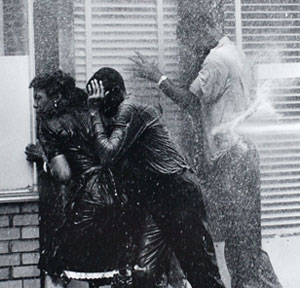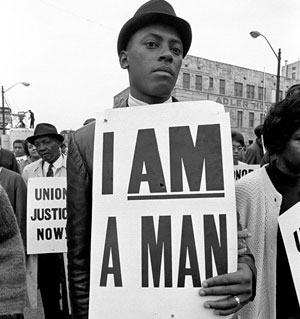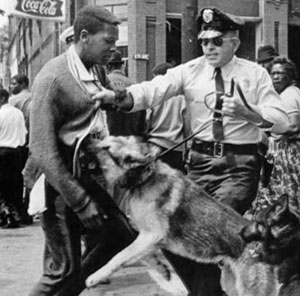For the past week we’ve been looking at the civil rights movement in honor of the 50th anniversary of the March on Washington. Today designer Bobby Martin, who runs the Original Champions of Design agency in New York, shares three lessons about what churches can learn from the civil rights movement. Here are his simple lessons:
1. Document everything.
Some of the best lessons for future generations stems from photography and journalism of the civil rights movement.

Shocking images, video and stories of the civil rights struggle helped galvanize support from across the nation, leading to passage civil rights legislation.
2. No more committees.
The most memorable work gets made when one person has the guts to make a decision and go with it. Leadership is important.
Some of the most important advances of the civil rights movement were actions of individuals or groups acting on their own without direction from civil rights leaders or organizations: Rosa Parks refusing to give up her seat, college students in Greensboro, N.C., sitting at segregated “whites only” lunch counters and the Freedom Riders who rode on into Mississippi after mob violence in Alabama, against the advice of leaders including Fred Shuttlesworth. Even during the Montgomery bus boycott that Rosa Parks incited, the people led the way:
When some seventy ministers and other black leaders gathered at the Dexter Avenue Church that evening, they were met with a fait accompli. Realizing, as Jo Ann Robinson wryly put it, that their congregations “were planning to support the one-day boycott with or without their … leadership,” the ministers “decided it was time for them, the leaders, to catch up with the masses.” (Freedom’s Daughters: The Unsung Heroines of the Civil Rights Movement from 1830-1970)
3. Keep messaging straight-forward and direct.
Bold and simple type works best to convey a clear message. “I AM A MAN” says it all: 
These prominent “I AM A MAN” signs were used during the Memphis sanitation strike in 1968. Martin Luther King Jr. was in Memphis supporting the strike when he was killed.
In a 2008 conference, Bobby Martin shared how the civil rights movement inspired his work at Abyssinian Baptist Church in New York:
“I learned I could use graphic design for more than just making things pretty. I could use graphic design to make a difference.”
Learn More
For more on the civil rights movement check out our archives:
- The March on Washington 50 Years Later
- The March on Washington, Racism & Church Diversity With Trillia Newbell
- Church Communication Hero: The Work of MLK, The Dream of MLK, The Words of MLK and our original hero piece on Martin Luther King Jr.
- The Last of a Generation: Church Hero Fred Shuttlesworth
- Our review of Church Diversity: Sunday the Most Segregated Day of the Week
- Church Diversity Sucks: Why Diversity Matters
- Social Club or Thermostat Church?






Mark
August 28, 2013
I know it is a small and petty point. But the people you mentioned in #2 did not act alone. In all the cases you site there were hours and hours of prep work and community decisions.
I say this only because I think we need to get away from the idea that brave individuals make differences in the world. They do, but only if supported by many others. We need to no longer think that change happens because of the work of one person, but rather is the work of the community.
Thanks for ‘listening’ to my simple remark to your excellent post. Peace.
Nathan Hill
August 28, 2013
Yes – Rosa Parks had long been a strong activist, organizing to bring justice to black men and women who were not afforded justice, men who had been accused of raping women when in fact they didn’t and black women who could not get justice after being gang-raped by white men. In fact, she learned from some of the successes and failures of that hard work over many years and was able to bring that experience into the launch of the bus boycott.
I’d highly recommend reading Stride Toward Freedom, where MLK Jr. talks about the Montgomery story – all the committee meetings, all the fires that had to be put out when someone on one committee spread misinformation or misappropriated funds, all the conflicts and egos at play, the exhaustion and uncertainty about the work. Church stuff doesn’t change. It’s hard work moving people toward a vision.
Kevin D. Hendricks
August 28, 2013
Mark, I’d say “No more committees” is perhaps hyperbole. As Nathan points out in his comment, there certainly was a lot of work done through meetings.
I think Bobby’s point is that sometimes we over-organize and it takes an individual to simply act. While there was a ton of helpful organizing going on during the civil rights movement (all the car-sharing and taxiing during the bus boycott is a huge example), often times it was individuals who took the first step or sparked a bickering committee into action.
Ryan Cloverfield @Become Ordained Online
September 1, 2013
I’d recommend reading through Running Toward Freedom, exactly where MLK Junior. mentions the particular Montgomery account – all of the committee meetings, all of the shoots in which must be release while another person using one committee multiply falsehoods or even misappropriated funds, all of the conflicts and also egos with participate in, the particular low energy and also skepticism about the do the job. Cathedral material doesn’t alter. It’s working hard shifting men and women toward a eyesight. — Notice far more with: http: /http://www.ordained-ministers.com